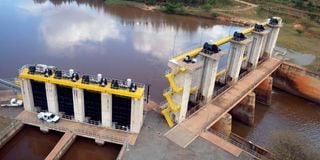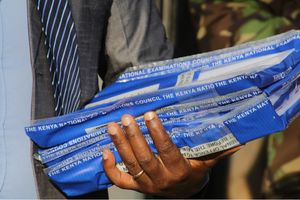Hydropower output rise offers consumers relief

Sondu- Miriu hydroelectric power plant in Kisumu County on February 14, 2018. The generation of hydropower from Kenya’s 16 major dams hit a one-year high last month.
Generation of hydropower from Kenya’s 16 major dams hit a one-year high last month following the end of the recent long-drawn drought, handing consumers a slight relief from higher charges from expensive diesel-generated electricity.
Data from the Energy and Petroleum Regulatory Authority (Epra) shows some 261.46 million kilowatt-hours (kWh) were generated from the hydro plants, which is more than double the 112.91 million units generated during the drought in February.
It is the highest amount of electricity that was generated from the hydropower plants since June last year when the power stations generated 264.86 million units, underlining the restoration of high water levels in the dams following the rains.
Since the long rains season resumed in March, hydropower generation has increased steadily, growing from 190.41 million units in April to 237.12 million units in May before shooting up to a 12-month high of 264.86 million units in June.
“Total units purchased from hydropower plants with a capacity equal to or above 1MW (megawatt) [were] 261,460,779kWh,” said Epra in a gazette notice.
KenGen-owned Gitaru hydropower plant, which is part of the Seven Forks Dams along Tana River, is the largest and generated 55.26 million units of electricity during the period.
Other top producers include Sondu Miriu (42.14 million units), Kiambere (39.13m), and Turkwel (38.09m).
Hydro generation hit a record low in February due to drought —the worst in more than a decade — that nearly exhausted Kenya’s major dams, putting at risk electricity production from one of the cheapest sources.
Hydro is Kenya’s second largest power source after geothermal. In the financial year to June 2022, Kenya Power bought 26.46 percent of its electricity from hydro sources. The surge in the generation of hydropower has led to a slight reduction in electricity prices as it has reduced the uptake of expensive thermal power produced from diesel. Thermal is by far the most expensive source of power fed into the grid in the country.
The Epra recently reduced electricity prices for July by 3.5 percent translating into lower power bills after reducing the fuel energy charge to Sh4.02 per unit from Sh4.49 last month.
The Authority further cut the forex rate fluctuation adjustment to Sh1.75 per unit down from Sh2.06 in June.
The net effect of the prices review is that a domestic ordinary customer who was paying Sh28 per kWh is now paying a slightly lower rate of Sh27 this month.
The ravaging drought, high cost of inputs such as fuel, fertiliser, and seeds, also saw food prices rise as local crop production dropp, forcing the government to raise importation.





